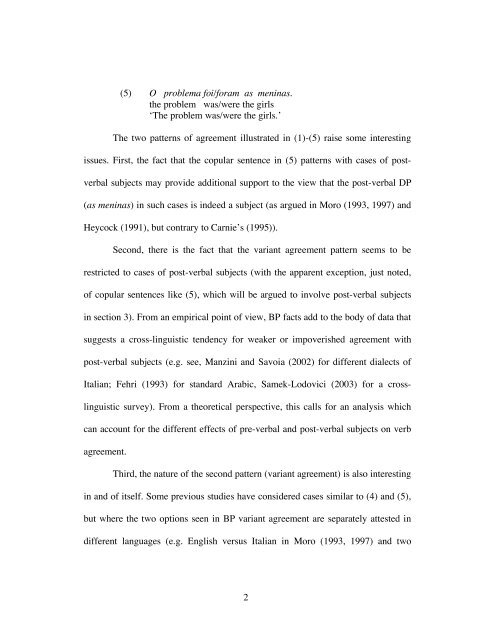Post Verbal Subjects and Agreement in Brazilian Portuguese
Post Verbal Subjects and Agreement in Brazilian Portuguese
Post Verbal Subjects and Agreement in Brazilian Portuguese
Create successful ePaper yourself
Turn your PDF publications into a flip-book with our unique Google optimized e-Paper software.
(5) O problema foi/foram as men<strong>in</strong>as.<br />
the problem was/were the girls<br />
‘The problem was/were the girls.’<br />
The two patterns of agreement illustrated <strong>in</strong> (1)-(5) raise some <strong>in</strong>terest<strong>in</strong>g<br />
issues. First, the fact that the copular sentence <strong>in</strong> (5) patterns with cases of post-<br />
verbal subjects may provide additional support to the view that the post-verbal DP<br />
(as men<strong>in</strong>as) <strong>in</strong> such cases is <strong>in</strong>deed a subject (as argued <strong>in</strong> Moro (1993, 1997) <strong>and</strong><br />
Heycock (1991), but contrary to Carnie’s (1995)).<br />
Second, there is the fact that the variant agreement pattern seems to be<br />
restricted to cases of post-verbal subjects (with the apparent exception, just noted,<br />
of copular sentences like (5), which will be argued to <strong>in</strong>volve post-verbal subjects<br />
<strong>in</strong> section 3). From an empirical po<strong>in</strong>t of view, BP facts add to the body of data that<br />
suggests a cross-l<strong>in</strong>guistic tendency for weaker or impoverished agreement with<br />
post-verbal subjects (e.g. see, Manz<strong>in</strong>i <strong>and</strong> Savoia (2002) for different dialects of<br />
Italian; Fehri (1993) for st<strong>and</strong>ard Arabic, Samek-Lodovici (2003) for a cross-<br />
l<strong>in</strong>guistic survey). From a theoretical perspective, this calls for an analysis which<br />
can account for the different effects of pre-verbal <strong>and</strong> post-verbal subjects on verb<br />
agreement.<br />
Third, the nature of the second pattern (variant agreement) is also <strong>in</strong>terest<strong>in</strong>g<br />
<strong>in</strong> <strong>and</strong> of itself. Some previous studies have considered cases similar to (4) <strong>and</strong> (5),<br />
but where the two options seen <strong>in</strong> BP variant agreement are separately attested <strong>in</strong><br />
different languages (e.g. English versus Italian <strong>in</strong> Moro (1993, 1997) <strong>and</strong> two<br />
2

















